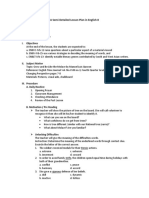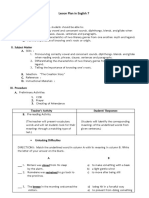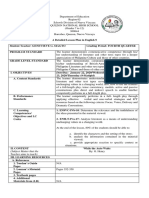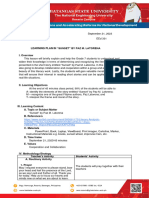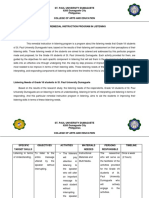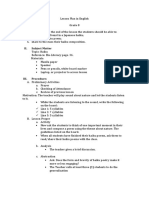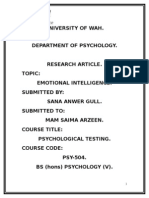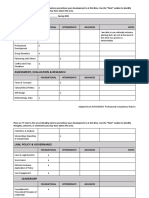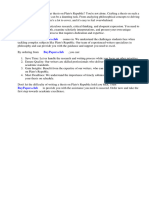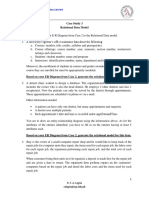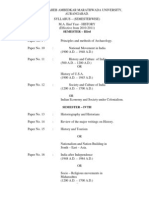Professional Documents
Culture Documents
Teaching Prose Detailed Lesson Plan
Teaching Prose Detailed Lesson Plan
Uploaded by
heystobitOriginal Description:
Copyright
Available Formats
Share this document
Did you find this document useful?
Is this content inappropriate?
Report this DocumentCopyright:
Available Formats
Teaching Prose Detailed Lesson Plan
Teaching Prose Detailed Lesson Plan
Uploaded by
heystobitCopyright:
Available Formats
Detailed Lesson Plan for Grade 11
Literary Elements in Prose
I. Objectives
During the teaching, learning process students are expected to:
1. Identify different Literary Elements in Prose
2. Appreciate different Literary Elements in Prose.
3. Give example of different Literary Elements in Prose.
II. Subject Matter
A. Topic: Literary Elements in Prose
B. Reference: Textbook and Online Resources
C. Materials: Instructional materials and Instructional media
D. Values Integration: Value the importance of different elements in
understanding Literary Piece.
III. Teaching Strategies
Teacher’s Activity Student’s Activity
A. Preliminary Activity
1. Prayer
Let’s start with a prayer. Please Our Father… Amen…
lead the prayer _____.
2. Greetings
“Good morning class.” “Good Morning Sir.”
“Please be seated.” “Thank you.”
3. Checking of Attendance
Our class monitor, who is absent “Sir I am happy to say that no one is
for today? absent for today.”
4. Review
Mechanics: The teacher will pass the
“Learning Task No. 1: Achy
Breaky Egg” egg to a student then the student will
pass it on to his/her seatmate while the
music is playing. When the music stops,
the student holding the egg will broke it
and then pick a question to read and
answer.
Critical Reader- A person who
applies processes, models and theories
that enhance comprehension.
Allusion- is a passing reference,
without explicit identification, to a
literary or historical person, place, or
event, or to another literary work or
passage.
Allegory- a narrative in which the
characters and their actions, and
sometimes the setting are contrived by
the author to represent something is
happening in the current situation.
Dichotomy- divides a concept, idea,
story, or plot into two equal and
contradictory parts; or between two
opposing groups.
Juxtaposition- is a technique wherein
two or more ideas, places, characters,
and their actions are placed side by side
Very Good class. I think you to develop comparisons and contrasts.
really understand our last topic that
means we can now proceed to our new
lesson.
B. Development of the Lesson
1. Motivation
“Learning Task No. 2: Guess
Me?”
(The teacher will flash riddles on (Student will read and answer the
the screen) riddle)
Answers:
1. P
2. R
3. O
4. S
5. E
Prose- a form of literature that
uses sentences and paragraphs
2. Activity
“Learning Task no. 3: arrange
Students Transform”
Mechanics: Class will be divided
into 7 groups. Each group will be
given an envelope that contains letters.
Rearrange the letters in order to form
the mystery word. After that the group
will post the mystery word on the board.
Yes it is.
Is that clear?
What comes to your mind
whenever you see those words?
Very Good.
We usually encounter that when
we read stories and novels.
“Sir Elements.”
Stories and novels are good
example of Prose.
Based on that activity and to the
question/s I have asked you, can you
guess what could be our topic for this “Sir I think it is about Elements in
day? Prose.”
Exactly! Very Good.
3. Analysis
Literary elements are used by
writers to make a text interesting to the
readers.
It helps also help to analyze and
understand the text better.
a. P
lot- the sequence of events
that make up the story, told in
either a chronological or a
non-chronological order.
Exposition- introduces the
character(s), setting, and situation.
Rising action- situation becomes
complicated, action gains force.
Climax- highest point of tension in
the story.
Falling action- events that lead to
the resolution of the conflict.
Resolution or Denouement-
loose ends are tied up, other matters
are drawn to a close.
b. Atmosphere in prose refers to
the creation of a mood or feeling
by the use of descriptions and
setting.
c. Characterization in prose
refers to how the author
describes the character, either
directly or indirectly through
action, using details or nuances
to add depth.
d. Conflict is the problem or
challenge faced by the character
or characters in the story.
e. Point of view the perspective
or vantage point of the speaker
or the narrator.
f. Setting is the time and place
where the story is set. It can also
include the weather, the social
and political climate, and the
cultural environment.
g. Theme is the central idea of the
story, and to an extent, the
purpose for its utterance.
Literary Techniques Used in
Prose
Literary techniques are used in
texts to convey its meaning.
Literary techniques give more
emphasis to a writer's ideas to
make them stand out.
1. Flashback is a scene or a
passage that interrupts the
present action of a plot to
introduce a past event.
2. Foreshadowing is the use
of clues or indication
suggesting at a future event
in the story. This is used to
arouse the reader's’ curiosity
and build up suspense.
Values Integration
(student’s answer may vary)
Is it important to know and
understand the different One of the benefits of knowing the
elements in prose? Why? literary elements and then calling
attention to them with your kids is that
these elements help writers become
intentional about how they craft their
thoughts into words. Too often,
mothers and educators focus on
improving writing through better
punctuation, grammar or format.
Elements are the fundamental building
blocks of writing, and they play an
important role in helping us write,
read, and understand literature.
Perfect, all of your answers are
correct.
(students will answer)
4. Abstraction
Plot- the sequence of events
To sum up what we have
discussed today again what are Atmosphere in prose refers to the
the different elements in prose? creation of a mood or feeling by the use
of descriptions and setting.
Characterization in prose refers to
how the author describes the character,
either directly or indirectly through
action, using details or nuances to add
depth.
Conflict is the problem or challenge
faced by the character or characters in
the story.
Point of view the perspective or
vantage point of the speaker or the
narrator.
Setting is the time and place where
the story is set. It can also include the
weather, the social and political
climate, and the cultural environment.
Theme is the central idea of the story,
and to an extent, the purpose for its
utterance
Wow! Great answers class, I am
happy that you understand our
lesson well.
5. Application
“Learning Task No. 5:
Pictionary”
Mechanics: The class will be
divided into 2 groups. Each
group will have their
representative to pick mystery
words. Then he/she will draw
image/s on the board that will
serve as cues for the remaining
members. The members of the
group will guess what the word
is. Correct answers correspond
to a point. The group that has
more number of points will
declare as the winner. Each
group will be given 2 minutes to
do the task.
Is that clear?
Yes, Sir it is!
IV. Assessment
A. Explain at least 3 of the Elements in Prose in your own words
B. Write a short story consist of one flashback and one foreshadowing techniques.
V. Assignment
Choose one of your favorite book or novel and identify the conflict, point of
view, characterizations, and setting.
TITLE:
Literary Element Description
CONFLICT
POINT OF VIEW
CHARACTERIZATIONS
SETTING
You might also like
- Benshoff Herry, 2016. Film and Television Analysis.Document49 pagesBenshoff Herry, 2016. Film and Television Analysis.Kristina SholomNo ratings yet
- Test Bank For Surgical Technology Principles and Practice 7th by FullerDocument24 pagesTest Bank For Surgical Technology Principles and Practice 7th by FullerJamesNewmanazpy100% (45)
- Group 5 (Semi-Detailed Lesson Plan in English 8 - Poetry)Document4 pagesGroup 5 (Semi-Detailed Lesson Plan in English 8 - Poetry)Mae Rose JuliandaNo ratings yet
- Name Noman Niaz: Stopping by Woods On A Snowy EveningDocument3 pagesName Noman Niaz: Stopping by Woods On A Snowy EveningNoman Niaz 13No ratings yet
- Detailed Lesson Plan Grade 11 Literary Elements in ProseDocument10 pagesDetailed Lesson Plan Grade 11 Literary Elements in ProseAra Ong100% (5)
- Lesson Plan in Teaching LitDocument2 pagesLesson Plan in Teaching Litnove quimpoNo ratings yet
- Lesson Plan in English IV FatzDocument6 pagesLesson Plan in English IV FatzClarin Je100% (1)
- A Semi-Detailed Lesson Plan in English 8Document3 pagesA Semi-Detailed Lesson Plan in English 8Anabel Marinda TulihNo ratings yet
- Lesson PlanDocument7 pagesLesson PlanDERYL SAZONNo ratings yet
- 5W's and 1H QuestionDocument11 pages5W's and 1H QuestionRubelyn MogelloNo ratings yet
- Lesson Plan in English 7 HappiestDocument4 pagesLesson Plan in English 7 HappiestSofia100% (1)
- Lesson Plan in English 7Document6 pagesLesson Plan in English 7Salve PetilunaNo ratings yet
- Rem. 2Document2 pagesRem. 2LadyNareth MierdoNo ratings yet
- Reading 22 and 23. While The Auto WaitsDocument3 pagesReading 22 and 23. While The Auto WaitsGenevieve Guimbongan SiagtoNo ratings yet
- A Detailed Lesson Plan in English 7 How My Brother Leon Brought Home A Wife I. ObjectivesDocument11 pagesA Detailed Lesson Plan in English 7 How My Brother Leon Brought Home A Wife I. ObjectivesJolina VelascoNo ratings yet
- Semi Detailed Lesson PlanDocument4 pagesSemi Detailed Lesson PlanRovigin Paula GARCIANo ratings yet
- Lesson Plan in English 7Document3 pagesLesson Plan in English 7Eljien LumbayoNo ratings yet
- Final Demo LPDocument18 pagesFinal Demo LPBob MagcantaNo ratings yet
- Detailed Lesson Plan FormatDocument5 pagesDetailed Lesson Plan FormatLeslie Felicia Peritos-FuentesNo ratings yet
- Semi-Detailed Lesson Plan For Anglo-American Literature: Republic of The PhilippinesDocument8 pagesSemi-Detailed Lesson Plan For Anglo-American Literature: Republic of The PhilippinesJammela TajanNo ratings yet
- El106 - DLP - The Little PrinceDocument6 pagesEl106 - DLP - The Little PrinceJydel RodriguezNo ratings yet
- Lesson Plan in Grade 8Document4 pagesLesson Plan in Grade 8Ramzel Joy DaldeNo ratings yet
- Lesson Plan Misplaced ModifierDocument3 pagesLesson Plan Misplaced ModifierBautista ShermineNo ratings yet
- LP#1 English Lit G7Document2 pagesLP#1 English Lit G7edelynNo ratings yet
- Subject:: Detailed Lesson Plan in Contemporary and Popular LiteratureDocument6 pagesSubject:: Detailed Lesson Plan in Contemporary and Popular LiteratureRona AlipaoNo ratings yet
- (Deductive Vs Inductive) Lesson PlanDocument2 pages(Deductive Vs Inductive) Lesson PlanDiana Laura Valdez100% (1)
- Department of Education: Detailed Lesson Plan in English 7Document10 pagesDepartment of Education: Detailed Lesson Plan in English 7Elvert Dela CruzNo ratings yet
- Detailed Lesson PlanDocument11 pagesDetailed Lesson PlanKaren100% (1)
- Final Lesson Plan in Philippine LiteratureDocument8 pagesFinal Lesson Plan in Philippine LiteratureErich Bonifacio0% (1)
- Verb Moods Lesson PlanDocument5 pagesVerb Moods Lesson PlanAnnabelle GakoNo ratings yet
- DLP #9 Eng 7Document2 pagesDLP #9 Eng 7Lenn DonNo ratings yet
- Lesson PlanDocument6 pagesLesson Planheneral lunaNo ratings yet
- Stages of Literature Learning in The ClassroomDocument44 pagesStages of Literature Learning in The ClassroomDanielle Akutagawa100% (1)
- He Walketh by DayDocument5 pagesHe Walketh by DayKim NamJoon100% (3)
- Lesson 1: Mapping: The Features of Philippine LiteratureDocument25 pagesLesson 1: Mapping: The Features of Philippine LiteraturePatricia FelicianoNo ratings yet
- Semi-Detailed Lesson Plan in English 8 - Second Grading I. ObjectivesDocument2 pagesSemi-Detailed Lesson Plan in English 8 - Second Grading I. ObjectivesMar Sebastian67% (6)
- ELT 7 Parts of Language ResearchDocument37 pagesELT 7 Parts of Language ResearchBagsit Angelique Khryztelle G.No ratings yet
- Lesson 2 Poem: Valediction Sa Hillcrest Let'S Warm Up!Document7 pagesLesson 2 Poem: Valediction Sa Hillcrest Let'S Warm Up!Angielyn Montibon Jesus0% (1)
- ACTIVITY 4: Drama: Rizal Technological UniversityDocument5 pagesACTIVITY 4: Drama: Rizal Technological UniversityANGELA MELLINA ADOR100% (1)
- Final Demo Lesson Plan - ParaisoDocument5 pagesFinal Demo Lesson Plan - ParaisoGlennson CopadaNo ratings yet
- Remedial Instruction in Listening ProgramDocument9 pagesRemedial Instruction in Listening ProgramMary Angelica Dejos ManganteNo ratings yet
- Activity Sheets 1st Quarter Grade 7Document4 pagesActivity Sheets 1st Quarter Grade 7Pau Jane Ortega ConsulNo ratings yet
- Japanese Haiku Poem 4's Lesson PlanDocument2 pagesJapanese Haiku Poem 4's Lesson PlanShanel Gutiérrez100% (2)
- "Of Studies" by Francis BaconDocument18 pages"Of Studies" by Francis BaconRo AnnNo ratings yet
- Auld Lang SyneDocument2 pagesAuld Lang SyneMartha Andrea PatcoNo ratings yet
- Overcoming Indifference 3Document4 pagesOvercoming Indifference 3RenzzyBautistaNo ratings yet
- Grade 7 Lesson PlanDocument4 pagesGrade 7 Lesson PlanstellamariceNo ratings yet
- Detailed Lesson Plan (DLP) Format: En9Lt-Iiia16 I. ObjectivesDocument2 pagesDetailed Lesson Plan (DLP) Format: En9Lt-Iiia16 I. Objectivesjoel rosal100% (2)
- Lesson Plan Indiscover Literature As A Means of Understanding The Human Being and The Forces He/she Has To Contend With.Document4 pagesLesson Plan Indiscover Literature As A Means of Understanding The Human Being and The Forces He/she Has To Contend With.Cristine Shayne BautistaNo ratings yet
- Bonsai LPDocument2 pagesBonsai LPMaper Anne Manalili100% (3)
- The Cultural Strains of Indian Literature (Short Stories)Document23 pagesThe Cultural Strains of Indian Literature (Short Stories)Kimi ChanNo ratings yet
- A Detailed Lesson Plan in Teaching A Poem 1Document12 pagesA Detailed Lesson Plan in Teaching A Poem 1maris ambaganNo ratings yet
- Role Play (Secondary) By: Group 1-LAE202 EDU005 Developmental Reading ActivityDocument5 pagesRole Play (Secondary) By: Group 1-LAE202 EDU005 Developmental Reading ActivityAileen DihikanNo ratings yet
- A Detailed Lesson Plan in English Grade 10Document15 pagesA Detailed Lesson Plan in English Grade 10Regine Gulane Briones Navarro100% (1)
- Identifying Materials and Resources and Applying Strategies in Teaching ProseDocument29 pagesIdentifying Materials and Resources and Applying Strategies in Teaching ProseKimberly Jane Lipaopao QuasayNo ratings yet
- Genres and Branches of LiteratureDocument6 pagesGenres and Branches of LiteratureRENATO JR. RARUGALNo ratings yet
- Semi LP HazeeDocument2 pagesSemi LP HazeeHazel Mae Herrera100% (1)
- 4a's Lesson Plan Figure of SpeechDocument12 pages4a's Lesson Plan Figure of SpeechJason Clark Ventirez0% (1)
- I. Objectives: Kto12 Curriculum Daily Lesson Log For Demo TeachingDocument5 pagesI. Objectives: Kto12 Curriculum Daily Lesson Log For Demo TeachingJoscelle Joyce RiveraNo ratings yet
- A Semi Detailed Lesson Plan in English Sample ReferenceDocument7 pagesA Semi Detailed Lesson Plan in English Sample Referencej.uganap.501880No ratings yet
- The Newdress L Esson PlanDocument3 pagesThe Newdress L Esson PlanJollyGay Tautoan LadoresNo ratings yet
- The Truth, Untold - Creating A PlotDocument9 pagesThe Truth, Untold - Creating A PlotheystobitNo ratings yet
- Literature Curriculum ConferenceDocument31 pagesLiterature Curriculum ConferenceheystobitNo ratings yet
- Activity No. 2 Spore Scope Graphic Org of Elements of Short StoryDocument1 pageActivity No. 2 Spore Scope Graphic Org of Elements of Short StoryheystobitNo ratings yet
- Final Version of Grade 9 (Q1-Q4) - Literature Curriculum ConferenceDocument32 pagesFinal Version of Grade 9 (Q1-Q4) - Literature Curriculum ConferenceheystobitNo ratings yet
- Mr. Gil M. Mallen JR., MaedDocument13 pagesMr. Gil M. Mallen JR., MaedheystobitNo ratings yet
- TIMSS Assessment Framework Outline (Group 3)Document7 pagesTIMSS Assessment Framework Outline (Group 3)heystobitNo ratings yet
- Deconstructive Analysis of Niel GarciaDocument3 pagesDeconstructive Analysis of Niel GarciaheystobitNo ratings yet
- Med Sci PostDocument122 pagesMed Sci PostTyeana CampbellNo ratings yet
- Kelompok 1 Claim (Ii Tbi A) Intermediate Reading SkillDocument4 pagesKelompok 1 Claim (Ii Tbi A) Intermediate Reading Skill0056 ravicayaslinaNo ratings yet
- Data Interpretation Practice ExerciseDocument4 pagesData Interpretation Practice ExerciseCompass DdunNo ratings yet
- Field Study 1 Learning Episode 8. Close Encounter With The School Curriculum Observe, Analyze, ReflectDocument11 pagesField Study 1 Learning Episode 8. Close Encounter With The School Curriculum Observe, Analyze, ReflectNica Elamparo Andales0% (1)
- Design Statement of Purpose Example PDFDocument1 pageDesign Statement of Purpose Example PDFlilith cipherNo ratings yet
- FORM 1 LESSON PLAN 2018 Pat 2019Document85 pagesFORM 1 LESSON PLAN 2018 Pat 2019meiphengchanNo ratings yet
- Evaluation of ActivitiesDocument2 pagesEvaluation of ActivitiesetwinningNo ratings yet
- Emotional Intelligence PDFDocument158 pagesEmotional Intelligence PDFdanion06No ratings yet
- Con Icts Management in Public Sector Nursing: International Journal of Healthcare Management July 2017Document9 pagesCon Icts Management in Public Sector Nursing: International Journal of Healthcare Management July 2017Novita PunkNo ratings yet
- Diazhe685-Competencies Self AssessmentDocument6 pagesDiazhe685-Competencies Self Assessmentapi-542304909No ratings yet
- CO Correction Boomerang GenerationDocument2 pagesCO Correction Boomerang GenerationSriguru ElumalaiNo ratings yet
- Research Papers On Platos RepublicDocument8 pagesResearch Papers On Platos Republicxbvtmpwgf100% (1)
- Robinson, Jennifer - Cities in A World of CitiesDocument23 pagesRobinson, Jennifer - Cities in A World of CitiesCarina GomesNo ratings yet
- Republic Act No. 10821Document6 pagesRepublic Act No. 10821Vens FabreNo ratings yet
- Case 3 - Relational Data ModelingDocument2 pagesCase 3 - Relational Data ModelingMichael John AbellonNo ratings yet
- Moot Court Case RespondentDocument63 pagesMoot Court Case RespondentSupriya GavaliNo ratings yet
- 2010HMF MS297Document2 pages2010HMF MS297Gadde SrinivasaraoNo ratings yet
- Ma History SyllabusDocument41 pagesMa History Syllabusabdulbari7788No ratings yet
- 2017-18 Ap English LanguageDocument10 pages2017-18 Ap English Languageapi-216774555100% (1)
- DLL - Science 4 - Q4 - W5 - 2Document4 pagesDLL - Science 4 - Q4 - W5 - 2jv100% (2)
- Q3 - WRITE SIMPLE STORY - Grade 3Document5 pagesQ3 - WRITE SIMPLE STORY - Grade 3Elimi Rebucas100% (4)
- ICA11 - Student Workbook Connect Internal HardwareDocument25 pagesICA11 - Student Workbook Connect Internal Hardwarevanhoang1973No ratings yet
- FBS SHS Quarter 3 Module 5 - RegionDocument33 pagesFBS SHS Quarter 3 Module 5 - RegionJovie ForsueloNo ratings yet
- Couns Activity Self Efficacy ScaleDocument12 pagesCouns Activity Self Efficacy ScaleandreeabitiuscaNo ratings yet
- Title-A Study of The Dropout Students in Primary Schools at Ratabari Constituency Under Karimganj District of Assam Chapter - IDocument30 pagesTitle-A Study of The Dropout Students in Primary Schools at Ratabari Constituency Under Karimganj District of Assam Chapter - IPROSENJIT ACHARJEENo ratings yet
- Blackboard Learn: 1.parameter AnalysisDocument9 pagesBlackboard Learn: 1.parameter AnalysisdhruvitNo ratings yet
- Lesson Plan in Math Grade 4 (4Th Quarter) : I. ObjectivesDocument7 pagesLesson Plan in Math Grade 4 (4Th Quarter) : I. ObjectivesEr Win0% (1)
- New Product Development and Product Life CycleDocument14 pagesNew Product Development and Product Life Cyclebhagshard05No ratings yet







